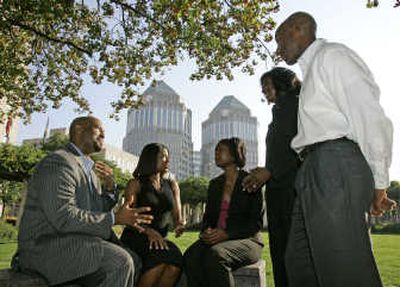P&G ad campaign courts black women

CINCINNATI – There’s a little-girl memory that Najoh Tita-Reid recounts, as a way of explaining what’s behind a new campaign by the nation’s biggest advertiser.
A young child in suburban Pittsburgh, she goes to play dolls with her neighbors, all of them white. Her doll stands out with its black color and features, and one girl says pointedly: “Najoh, our dolls can’t play with yours.”
Why not? “Because your doll is ugly,” comes the reply.
Fast-forward 30 years, and Tita-Reid is helping lead a Procter & Gamble Co. campaign called “My Black is Beautiful,” which combines marketing with forums meant to foster dialogue about black women and the way they are portrayed in popular culture.
The marketers involved say it’s a movement, not just advertising. But it aims at a group with growing buying power, estimated at more than $400 billion and is tied to brands including Olay skin care, Pantene shampoo, CoverGirl cosmetics, and Always and Tampax feminine care products.
P&G has placed a special advertising section in the Essence December issue that hit newsstands Monday and is working on store and community promotions. There’s a Web site, plans for a multi-city “conversation tour,” and grants to community organizations to support young black women.
The campaign has similarities to rival Unilever’s “Real Beauty” initiative for Dove, which focused on women’s self-image. It also fits with a marketing push by P&G, which spends $7 billion a year on global advertising, to build brand image and good will – and sales.
“It’s getting beyond the selling of the product,” said Mike Robinson, who heads Cincinnati-based LaVerdad Marketing & Media, focused on ethnic marketing. “You’re going to get more share of the heart, more share of the mind, and ultimately, more share of the wallet.”
Experts say mass marketers generally have been slow to target a black female population that is increasing in income, education and professional advancement. They say gains by black females are a major reason black spending clout is growing at a faster rate than the overall U.S. population’s – the Selig Center for Economic Growth at the University of Georgia estimates that black buying power of $799 billion in 2006 will be $1.1 trillion in 2011.
“There are a lot of different ways to talk to her, and I think a lot of companies are still way behind,” said Pepper Miller, of Hunter-Miller Group Inc. consulting in Chicago.
“We like to be courted,” said Pat Tobin, who runs a public relations firm in Los Angeles. “We want you to come after us; don’t take us for granted.”
“My Black” began with P&G research that showed black women were frequent users of beauty products, spending at three times the rate of the general female population. A P&G/Essence poll found black women overwhelmingly say they are portrayed worse than other groups in the media and pop culture.
“This was an affirmation of what we know about this woman,” said Michelle Ebanks, president of Essence Communications Inc. “There is so little content in media today that reflects African-American women overall. What does exist tends to be more stereotypical.”
The campaign was already in the works last spring when talk radio host Don Imus’ racially offensive comments about the Rutgers women’s basketball team caused a furor. P&G was among major companies to yank advertising.
“Don Imus just added another vector,” said Eric Higgs, of P&G’s multicultural marketing team. “It was really a loud and clear message that this was right for us to do.”
Tita-Reid, associate marketing director of the multicultural team, sees “My Black” helping pave the way for her infant daughter.
“I see an incredible future for her; I see African-American women celebrated for their beauty and diversity and being empowered to challenge the way they are portrayed,” she said. “I would have played a small part in that.”